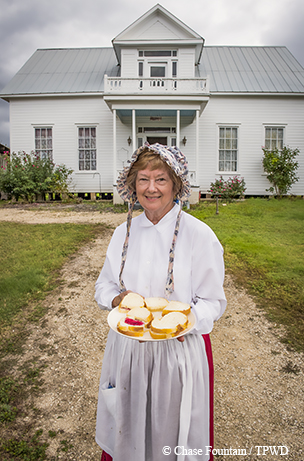
Game Warden's Gonzales
Destination: Gonzales
Travel time from:
Austin – 1.5 hours
Dallas – 4 hours
El Paso – 9 hours
Brownsville – 4.5 hours
Houston – 4.5 hours
Lubbock – 7 hours
Retired lawman knows the history and haunts of the birthplace of Texas independence.
By Sheryl Smith-Rodgers and photos by Chase Fountain
Glen Sachtleben, a retired Texas game warden, has traveled the backroads and main arteries of Gonzales County more than most. He can also bend ears on how Gonzales came to be the birthplace of Texas independence and throw in some swamp lore, too. Sometimes he even turns up in a story or two himself.
Based in Gonzales, Sachtleben (pronounced “sock-layben”) started as a game warden at age 21 in 1969.
“Back then, four game wardens shared one ‘portable’ radio that had only one TPWD frequency and ran on 24 D-cell batteries,” he recalls, chuckling. “You sure didn’t pack that thing around!”
After 30 years on the job, Sachtleben retired in 1999 and the next day was sworn in as Gonzales County sheriff. He served 17 years before handing off the reins to a successor in December 2016. Now completely retired, he recently gave my husband, James, and me what he calls his “nickel tour” of the area. At the wheel of his white SUV, Sachtleben — still sheriff-esque in his beige cowboy hat, sideburns and walrus mustache — told nonstop stories about historic landmarks and special places in and around Gonzales.

He starts off with the history of Gonzales, which began under Mexican rule in 1825. That year, land agent Green DeWitt and surveyor James Kerr founded the city and named it after Rafael Gonzales, then governor of Coahuila and Texas. A year later, conflicts with Native Americans forced settlers to abandon the site, and the city later moved to its present location.
“Gonzales was laid out in the Spanish-style shape of a cross, using a compass, a chain and varas, a Spanish unit of measurement,” Sachtleben explains. “Our county courthouse is the center of a cross that’s made of seven plazas. They were originally reserved as space for schools, churches and cemeteries.”
They still are. Through the years, other public-owned entities have located on the avenues. Grade schools, the high school football stadium, the main post office, city parks, a museum and a college all stand on avenue land.
Meanwhile, Native American conflicts continued to plague Gonzales. In March 1831, Mexican officials loaned the town a small bronze cannon for protection. When Texans began to push for independence, Mexico wanted its cannon back. In September 1835, Mexican soldiers from San Antonio came to take it. Gonzales residents refused. Instead, 18 men — dubbed the Old Eighteen — called for help and hid the cannon in a local peach orchard.
“That’s the site where they buried the cannon,” says Sachtleben, driving us past a stone monument that’s shaded by two peach trees on St. Louis Street.
Across the Guadalupe River, more Mexican soldiers arrived. By Oct. 1, more than 150 Texans had joined the Old Eighteen. Women hurriedly made a flag from a strip of white cotton cloth. On it they painted in black a picture of the cannon, a five-pointed star and the words “Come and Take It.” The Texans dug up the cannon, mounted it on ox-cart wheels and draped it with chains. Then they headed west toward the army’s camp.
Early the next morning, they stood their ground with the cannon against the Mexican troops and dared the soldiers to “Come and Take It.” Skirmishes ensued.
The Texans fired the little cannon, which sent the Mexicans scurrying back to San Antonio.
A short drive on Texas Highway 97 west to Cost takes us to a roadside memorial, which honors the Battle of Gonzales and that first shot of the Texas Revolution. The bronze sculpture set in a block of carved granite depicts Texans rallied around a smoking cannon. Farther down Spur 95, we take our pictures by the “first shot” stone marker erected in 1936.

Back in Gonzales, Sachtleben ushers us into the narthex of the First United Methodist Church.
“This is one of our best-kept secrets,” he says of a colorful mural that covers surrounding walls. One scene — painted by Tennessee artist Lynne Looney — depicts Gonzales men ready to go to battle against the Mexicans with their rifles, the white flag and the bronze cannon. Local residents posed as models for the mural.
“You might see a sheriff on a post office wall but not a church wall!” Sachtleben quips. “Yep, that’s me up there. I’m one of the gun-toting Texans and a Methodist circuit rider on horseback.”
East of the courthouse, we visit the Gonzales Memorial Museum, an Art Deco-style complex completed in 1937 to celebrate the state’s centennial. On the grounds, two monuments honor the Old Eighteen and the Immortal Thirty-Two. The latter were 32 Gonzales men who were the only volunteers to respond to William Travis’ plea for reinforcements at the doomed Alamo. Two exhibition halls display period rifles, historic documents, artifacts and photos, vintage clothing and the famous “Come and Take It” cannon strapped to a wooden axle and wheels.
However, not all historians agree on the cannon’s authenticity.
“Based on what I’ve read by pioneer Noah Smithwick and the late Thomas Ricks Lindley, I’m satisfied that we have the right one,” Sachtleben says.
Behind him, docent JoLaine Schurig nods.
“Until they bring me another cannon, I’m going with that one!” she says, smiling.

After the Alamo fell March 6, 1836, Sam Houston arrived in Gonzales to organize a military for the newly formed Republic of Texas. On March 11, he ordered that Gonzales be burned and Texans retreat ahead of the oncoming Mexican army. The mass evacuation became known as the Runaway Scrape.
We pile back into the SUV for a 10-mile trip east on U.S. Highway 90 Alternate. Sachtleben pulls off the highway onto a dirt road. Behind a private ranch gate, we glimpse a white two-story house flanked by a majestic live oak with low-spreading branches.
“This site near Peach Creek was a day’s travel from Gonzales,” Sachtleben says. “Both Sam Houston and Santa Anna with their troops camped around this tree on their way to San Jacinto.”
“At the time, the McClure family lived in a log cabin that once stood here,” he continues. “Bartlett McClure died, and his wife, Sarah, remarried Charles Braches. That two-story house was completed around 1843 and served as a stopping place for stagecoaches and wagon trains.”
In downtown Gonzales, Sachtleben points out the fire department’s unusual weather vane. The golden steer — crafted in the 1880s and branded with T41 — once topped a Gonzales mansion. Across the street is the Gonzales County Jail Museum.
“When I was a game warden, I worked out of this jail,” says Sachtleben of the three-level brick jail built in 1887 and used until 1975. Today the jail serves as a museum, visitors center and office space for the Gonzales Chamber of Commerce. Following Sachtleben, we step into dimly lit cell rooms and up an iron staircase to see the rusty barred cellblocks, replica wooden gallows and walls scratched up with graffiti.
“I’m going to tell you a story,” Sachtleben says. “A local legend goes that a man awaiting execution in this jail insisted he was innocent. From where he waited, he could see the courthouse’s clocks. He swore that, when he died, citizens could never again use the clocks to tell time. During the years I worked here, every face of the four courthouse clocks showed a different time.”

Our nickel tour includes the Gonzales Pioneer Village Living History Center, a 10-acre complex of 15 historic buildings from the 1860s to early 1900s.
We wander into a white-frame church with a pulpit fashioned from a dynamite box. Behind a wood-shingled granary, two resident goats, Sweetheart and Virginia, happily browse on grass. Inside the well-to-do Muenxler House, tour manager Anna Welch, who insists there's no such thing as ghosts, tells us about voices she often hears insude the homes that's furnished with original family belongings.
As game warden and sheriff, Sachtleben frequented the tiny community of Ottine and Palmetto State Park, a tropical getaway known for its dwarf, fan-shaped palms.
“When I started as a game warden, the park was lush with palmettos, and the mud boils were still active,” he recalls as we drive past forest floors spiked with native palmettos. We peek into the red stone refectory built by the Civilian Conservation Corps and pass by Oxbow Lake, where visitors can rent canoes, kayaks and pedal boats.
“This is a gorgeous pocket of Texas,” says park Superintendent Elizabeth Palfini. “I feel sorry for people who drive by on U.S. 183 and don’t stop to see this place.”
According to Sachtleben, many Gonzales residents enjoy visiting the park but never after sunset. “A monkey-like creature lives in the woods,” he confides. “After dark, it follows people and throws rocks at them. It’s known as the Swamp Thing or the Ottine Swamp Monster. I know grown men who will not come out here at night!”
“I’m going to tell you a story,” Sachtleben tells us again. “In the 1990s, I dressed up as the Swamp Monster for a festival here in the park. I conjured up a Wookie mask, and my wife made me a camo suit. I rode a motorcycle in the parade, and people gave me jellybeans so I’d be their friend.”
Later, over a plate of brisket at Baker Boys BBQ in Gonzales, our host reflects back on his professional careers in historic Gonzales.
“I’ve done what I’ve wanted to do in life and gotten away with it,” Sachtleben says. He wipes his mustache with a paper napkin and grins. “Mostly, that is.”
More Info:
|
» Like this story? If you enjoy reading articles like this, subscribe to Texas Parks & Wildlife magazine.
Related stories
See more travel stories on TP&W magazine's Travel page

